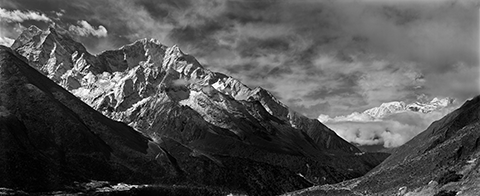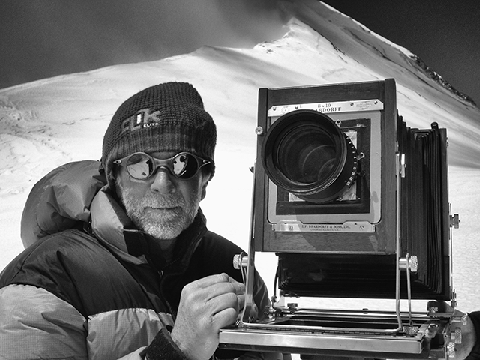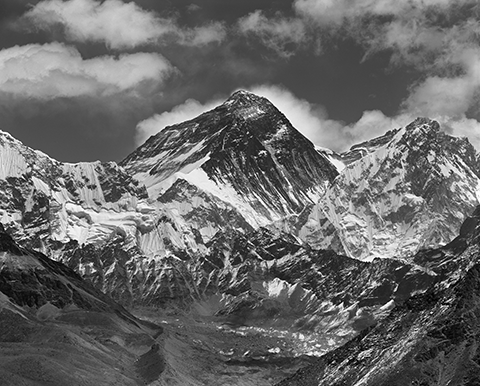Large format photo tribute to the Himalayas

The Himalayas have 598 mountains that are over 20,000 ft. US-based photographer Jeff Botz trudged up to Everest Advance Base Camp with his 8x10 camera to capture some unseen images

Remember the acclaimed 1984 National Geographic documentary 'Back to Everest' and the front cover image of an imposing snow-clad peak? Well, it wasn't a photograph of the highest mountain in the world. It was of Ama Dablam, one of the most popular 6,856mts (22,493 ft) peak permitted for expeditions in the Himalayas in eastern Nepal.
Like thousands of mountaineers and photographers who watched the documentary, American shutterbug Jeff Botz also got his copy but his thoughts were clouded on seeing the cover photo realizing that it was not of the subject in the film.
"Back in the day I rented the video of 'Return to Everest' and I asked myself what mountain this is. It turned out to be Ama Dablam, because Mt Everest doesn't look like that and they didn't really have any decent pictures of it," said Botz, a Himalayan photographer who belongs to a rare breed of people who worship large format 8"x10" black and white photography.
Giving a lecture recently at the Explorers Club in New York, titled 'Portrait of Everest', Botz continued, "… and so I said here's a photographic void and everybody's trying to find a photograph (of Everest) and I think I should do this. And in 1998, I built a camera from a kit".
On May 9th 2012, Botz set up his 8"x10” view camera at 6,660mts (21,854 ft) on Mt Everest to photograph the North Col, he achieved two things: first, the highest recorded deployment of such a camera in human history; second, he created the final picture in his fourteen year quest to create the first ever comprehensive photographic survey of the world’s tallest mountain and its surroundings. This project, on which he has logged over 200 days of field shooting, includes all three sides of the world’s tallest mountain.
Botz said the absence of photos of Everest in the 1997 bestseller 'Into Thin Air' by John Krakauer further reinforced his idea to go to the Himalayan region for large format images of the mountain and its surrounding peaks. "I had been to the Himalayas in the 1970's and spent four months there in 1976-'77. In 1972, I'd captured them in a 35 mm color photograph."
Inspired by the large format photography style of Ansel Adams, Botz thought this would be the perfect technique to realize a photographic vision of the Himalayas as opposed to the 35 mm slides. "I knew it in my head I would change every single color slide I ever took for an Ansel Adams type image of a mountain in the Himalayas. Also, the format of the 35 mm is only one inch and what I'm saying is when you have a 12,000 ft subject... to reduce it to one inch film, an item like the size of this building is lost," he added.
Studying (badly taken) satellite images, Botz saw that Mt Everest is a naturally occurring 3-sided pyramid with sides of five miles, each one is five miles across and each one of these sides has its own glacier that these big faces that are five miles across wash down a bunch of snow and ice and those are the ways to approach Everest.

Armed with his 50 pound equipment, including camera, tripods inside a customized rucksack, Botz went to the three basic approaches: Kumbhu on the south side, Kangshung valley (China side) and Rongbuk on the north side. Within a 16 mile circle there are four of the tallest six mountains in the world. Everest (1), Lhotse (4), Makalu (5), and Chohoyu (6) and his aim was to get the clearest photographs of all these mountains.
Botz describes his visit to the Kangshung side in 2003 as "most exciting" as this is the least visited side of Everest. "It's hard to get over there (as compared to the Nepal side) and we took yaks. Else, it's a two and half days' walk. The yaks got stuck in the snow and the yak driver had to remove all the material and pull them out of snow before we got going. It's quite beautiful and rugged. You have to carry your own food and your own tents and its nothing like Kumbhu where you can get a tea house and for three bucks you can get a room. After going up a 17,000 ft ridge and then down into the Kengshung side you can see the Everest group... Lhotse and Lhotse sharp," he added.
Botz, while not condemning digital photography, said most amateur photography in the Himalayas is drawn by two factors: the availability of light weight equipment, "Anybody who set off to Everest is immediately asked to take the lightest camera they find. And of course, light means small format, probably at the best it's gonna be. Well, in those days, it used to be 35 mm but now-a-days it's your 10-20 mb capture from the DSLR.
"The other type is: people taking pictures for the internet, for publication and they're small (4x6) (6x10). But my photograph has been driven by emotional, philosophical and artistic needs with total disregard for commercial outlets and financial gain (unfortunately)."
Showing images of 'twin sisters (part of Makalu range, towering over 20,000 ft), Botz said, "When I made this image. I converted it to 72 BPI (Bits Per Inch) which could go on the projector screen and they told me that this picture, at full size, would be 13 ft high and 19 ft wide. It wouldn't fit on the wall here. This type of photography has the real capacity to give you an idea of the height of these mountains. The most sold photos in the world are all taken in 8"x10" format. The digital photographs are commercially and editorially driven".
Describing the ostentatious Chinese expeditions to Everest with some tongue in cheek remarks, Botz showed photographs of well-decorated tents with much better heating facilities than most expeditions do, a menu with delicacies that one could kill for at that altitude, booze driven parties and a billionaire mountaineer's plastic, trasparent tent with a (hazy) view of the mountain.
Spurred by mountaineering legend Reinhold Messner's description of the view from a place called Rabhu La in his book 'The Crystal Horizon', Botz trekked the North Col route to photograph the surroundings that the legendary mountaineer had so well narrated but fell 10 ft into a crevasse and found himself staring at a blackish abyss 20 ft further.
The photographer used the dying minute of his hour and half long lecture to speak about an issue close to his heart, that of renaming Everest after its traditional names. "George Everest didn't even scale the mountain. The Tibetans call it 'Chomolungma' (goddess mother of the universe) and Nepalis, 'Sagarmatha'. These two names are significant to the culture of these two places but the people here live under the shadow of Everest," he said in conclusion.

Image © Jeff BotzPlace: New York





Comments ()